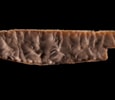Flint Dagger
This caramel-coloured flint knife is distinctive and is of a type known as a ‘ripple-flaked knife’. Knives like this appear in graves corresponding to phase Naqada IIC/D (roughly 3600 to 3350 BC); they are often considered to be one of the ‘signature’ artefacts of this part of the Predynastic period. Many of ripple-flake knives found in graves show little evidence of wear on the edges. Some, however, were ritually ‘killed’ during funerals and laid carefully in burials in two halves, such the example from Gerzeh grave 25, now in the Pitt Rivers Museum (1911.33.1). They were made by applying pressure to a localized area to remove small pieces of flint, thereby giving a rippled effect, rather than striking the flint with another implement. The curved edge was finely serrated and the base and distal ends were also retouched. Regardless of where they are found all are virtually identical in style. This has led flint analysts to argue that they may have been produced by a group of workshops in one area and may be the product of a few craftsmen who practised this extremely specialized skill over a period of a few generations (Holmes 1989, 338). The butts of such knives are broad and those examples with handles had to be chipped down to a narrow wedge in order to fit into their ivory holds. This suggests that the flints were only later adapted, possibly some time after their production. The aesthetic appeal of these knives emanates not only from their impressive workmanship, but also from the care taken in the selection of raw material on which they were made. Flint is widely available along the Nile between Cairo and Esna within the limestone outcrops, but caramel-golden coloured pieces were preferentially selected for the most specialist knapping (Holmes 1992, 39), perhaps because they resembled the colour of metals.
The MacGregor Collection of Egyptian Antiquities, Sotheby, Wilkinson & Hodge, London, 26th June - 3rd July 1922, Lot 1146.
The Ernest Brummer Collection of Egyptian and Near Eastern Antiquities and Works of Art, Sotheby & Co, London, 1964, Lot 1.
Important Classical, Western, Asiatic and Egyptian Antiquities, Christie’s, New York, 25 January 1979, Lot 100.
Previously in the Private Collection of Reverend William MacGregor (1848-1937), Bolehall Manor, Tamworth, UK, prior to 1922 and likely prior to 1898.
Sold at: The MacGregor Collection of Egyptian Antiquities, Sotheby, Wilkinson & Hodge, London, 26th June -3rd July 1922, Lot 1146.
With Ernest Brummer (1891-1964).
Sold at: The Ernest Brummer Collection of Egyptian and Near Eastern Antiquities and Works of Art, Sotheby & Co, London, 1964, Lot 1.
Private Collection.
Sold at: Important Classical, Western, Asiatic and Egyptian Antiquities, Christie’s, New York, 25 January 1979, Lot 100.
Private Collection, Australia, acquired from the above sale.
ALR: S00208929, with IADAA certificate, this item has been checked against the Interpol database.










 Enquire
Enquire




